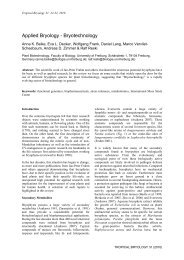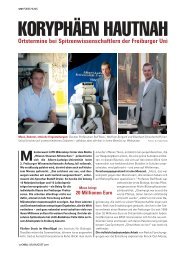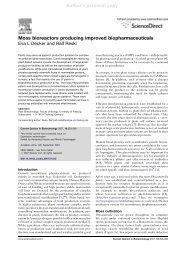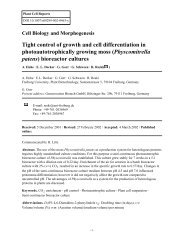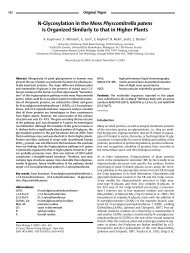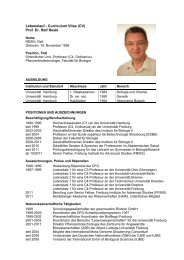Diversification of ftsZ During Early Land Plant Evolution
Diversification of ftsZ During Early Land Plant Evolution
Diversification of ftsZ During Early Land Plant Evolution
You also want an ePaper? Increase the reach of your titles
YUMPU automatically turns print PDFs into web optimized ePapers that Google loves.
156<br />
2001), we wanted to include as many as possible moss<br />
sequences into the phylogenetic analysis to clarify<br />
when during land plant evolution the separation into<br />
two gene families took place.<br />
We searched a clustered Physcomitrella EST database<br />
(Rensing et al., 2002) for <strong>ftsZ</strong> homologues and<br />
subsequently cloned and sequenced the genes <strong>of</strong> two<br />
new Physcomitrella patens <strong>ftsZ</strong> family members to<br />
enable a better understanding <strong>of</strong> the evolution <strong>of</strong><br />
these plant gene families.<br />
Materials and Methods<br />
Cloning and Sequencing<br />
Two new Physcomitrella patens <strong>ftsZ</strong> genes are being presented in this<br />
study, <strong>ftsZ</strong> 1-1 (AJ428993) and 1-2 (AJ428994). From a clustered<br />
EST database covering nearly the whole transcriptome (Rensing et<br />
al. 2002), clusters defining the previously unknown sequences were<br />
revealed by homology searching with members <strong>of</strong> the plant FtsZ1<br />
family. Subsequent cloning and sequencing as well as RACE-PCR<br />
using the RLM-RACE Kit (Ambion, Germany) yielded the fulllength<br />
cDNA sequences. To analyze the genomic structure <strong>of</strong> the<br />
genes, different sets <strong>of</strong> primers were synthesized. Genomic DNA was<br />
extracted as described previously (Reski et al. 1994) and used as<br />
template for PCR amplification. The resulting PCR products were<br />
subcloned in pCR 4-Topo (Invitrogen, Germany) and both strands<br />
sequenced with appropriate overlaps by primer walking.<br />
S<strong>of</strong>tware<br />
The GCG Wisconsin package 10.2 (Accelrys, USA) was used for<br />
sequence analysis as well as CLUSTAL W 1.81 (Thompson et al.<br />
1994) for multiple sequence alignment. Homology searches were<br />
conducted with BLAST 2 (Altschul et al. 1997). Phylogenetic trees<br />
were created with TREECON 1.3b (Van de Peer and De Wachter<br />
1994) and TREE-PUZZLE 5.1 (Schmidt et al. 2002). Peptide distances<br />
were calculated from the alignment using the GCG s<strong>of</strong>tware<br />
Distances with Kimura parameters.<br />
The GENPEPT database (release 124.0; www.ncbi.nlm.nih.<br />
gov), being a conceptual translation <strong>of</strong> GenBank, was used as a<br />
peptide database covering the known protein coding genes from all<br />
organisms. The FtsZ and tubulin motifs were extracted from<br />
PROSITE (release 16.37; www.expasy.ch).<br />
Database Searches<br />
BLASTP searches against GENPEPT as well as TBLASTN<br />
searches against the GENBANK EST_OTHER division (nonhuman/mouse)<br />
were run using full-length FtsZ peptide sequences<br />
known to belong to the plant FtsZ1 family (Pisum sativum) and<br />
FtsZ2 family (Gentiana lutea). From the significant hits a subset <strong>of</strong><br />
33 sequences was extracted for further analysis, covering all photosynthetic<br />
organisms (cyanobacteria, algae, and land plants).<br />
Redundant sequences were removed and some ESTs clustered<br />
(Table 1).<br />
Alignment and Tree Reconstruction<br />
The above-mentioned peptide sequences were subjected to a multiple<br />
sequence alignment using default parameters, leading to an<br />
alignment <strong>of</strong> 530 positions. Manual inspection <strong>of</strong> the alignment did<br />
not reveal any obvious errors, therefore it was not altered before<br />
further analyses took place. Neighbor-joining trees were done using<br />
the Tajima and Nei (1984) model; InDels were not taken into account.<br />
Maximum likelihood analysis was done using the Whelan<br />
and Goldman (2001) substitution model with data set frequencies,<br />
exact parameter estimation, and eight gamma distributed heterogeneity<br />
rates.<br />
Results and Discussion<br />
Isolation <strong>of</strong> Two New moss <strong>ftsZ</strong> Genes; Comparison<br />
with Arabidopsis<br />
We cloned and sequenced both the full-length cDNA<br />
and the genomic loci <strong>of</strong> two novel <strong>ftsZ</strong> genes. These<br />
new Physcomitrella <strong>ftsZ</strong> homologues group in the<br />
land plant FtsZ1 family (see below) and therefore<br />
are designated <strong>ftsZ</strong> 1-1 and <strong>ftsZ</strong> 1-2. The two previously<br />
published <strong>ftsZ</strong> homologues 1 and 2 (Kiessling<br />
et al. 2000) cluster in the land plant FtsZ2 clade<br />
and are therefore renamed <strong>ftsZ</strong> 2-1 and <strong>ftsZ</strong> 2-2,<br />
respectively.<br />
The genomic organization <strong>of</strong> the Physcomitrella<br />
and Arabidopsis <strong>ftsZ</strong> genes is shown in Fig. 1.<br />
Whereas the sequences <strong>of</strong> <strong>ftsZ</strong> 2-1 (‘‘1’’) and 2-2 (‘‘2’’)<br />
remarkably resemble each other (Kiessling et al.<br />
2000), <strong>ftsZ</strong> 1-1 and 1-2 show a different organization.<br />
The genes for 2-1 and 2-2 both contain six introns in<br />
conserved positions and differ mainly in the slightly<br />
different sized exon 1 and intron 6. FtsZ 1-1, on the<br />
other hand, contains five introns about evenly spaced<br />
among the sequence, whereas 1-2 is host to just three<br />
introns that resemble the positions <strong>of</strong> introns 2, 3,<br />
and 4<strong>of</strong> 1-1 or introns 1, 2, and 3 <strong>of</strong> 2-1/2-2. The<br />
close relationship <strong>of</strong> <strong>ftsZ</strong> 2-1 and 2-2 makes it probable<br />
that these genes were duplicated only recently, in<br />
terms <strong>of</strong> evolutionary history. Whether or not 1-1<br />
and 1-2 share a recent common ancestor, i.e., evolved<br />
by duplication <strong>of</strong> the gene and subsequent insertion<br />
or deletion <strong>of</strong> introns, cannot be answered yet.<br />
Although FtsZ 2-1 and 2-2 predictably have a low<br />
evolutionary distance (17.78 substitutions per 100<br />
positions), they share with 1-1 (86.95/86.98) and 1-2<br />
(93.63/94.81) about the same distance as the latter<br />
two among each other (92.36).<br />
In comparison with the Arabidopsis genes it becomes<br />
evident that Arabidopsis <strong>ftsZ</strong> 2-1 and 2-2 have<br />
a genomic structure resembling that <strong>of</strong> Physcomitrella<br />
<strong>ftsZ</strong> 2-1 and 2-2, whereas Arabidopsis <strong>ftsZ</strong> 1-1 is remarkably<br />
similar to Physcomitrella <strong>ftsZ</strong> 1-1.<br />
Figure 1 also displays a structural feature <strong>of</strong> the<br />
FtsZ proteins: the tubulin/GTPase motif-containing<br />
exon (pink). Because <strong>of</strong> the fundamental importance<br />
<strong>of</strong> this motif for FtsZ function, we assume that<br />
the exon harboring the tubulin/GTPase motif is<br />
homologous throughout the genes, as is also the case<br />
for the two introns bordering this exon. There are in



